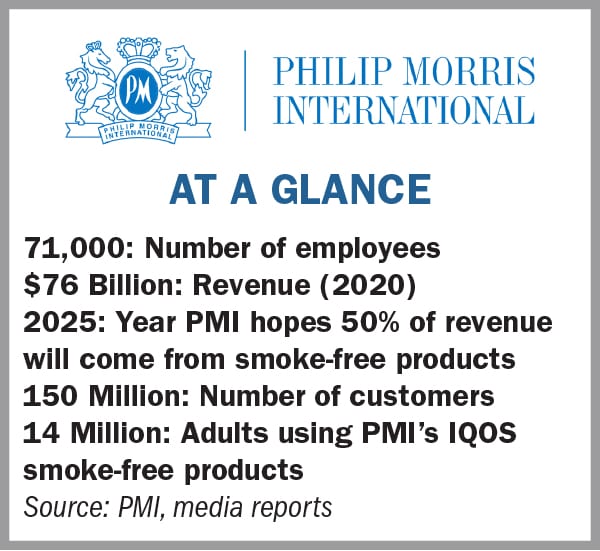
Editor’s Note: In small companies, staff sometimes find it difficult to know how the company is doing. What about at a global company like Philip Morris International (PMI), with 71,000 employees? Add that PMI has said it’s transforming itself from cigarettes–responsible for all its revenue in 2015–to smoke-free products.
How do its internal communicators keep everyone on the same page during a pandemic and in normal times? That’s some of what we asked PMI’s head of global internal communication Bessie Kokalis Pescio. In addition, we asked how internal communicators at small companies should approach their work. Her remarks were lightly edited.
PRNEWS: PMI is in the midst of moving from cigarettes to smoke-free products. In the midst of that, the global pandemic hit. What did you do to keep internal communication moving ahead?
Bessie Kokalis Pescio: I’ll give you an example. Our chief operating officer Jacek Olczak, who [just became] our CEO, typically comes into the office at our headquarters here in Lausanne and likes to stop at the coffee corner and converse with employees. So, employees stop by and chat with him. Tell him what’s on their mind, just exchange [small talk] with him. He enjoys that. It’s very much in line with his values of transparency and learning and listening.
What we did was we took that format and replicated it digitally for him and for employees from around the world. So, instead of him interacting with employees at our headquarters, we extended that opportunity to employees across the organization, in all different functions, geographies and levels.
We invited them to an ‘E-Coffee Corner with our COO.’ That’s created...opportunities for conversations and insights from our COO and employees who otherwise would never have had such an opportunity.
PRNEWS: Cool idea.
Kokalis Pescio: Another example is what we call ‘Online Challenges.’ We do them through Yammer. At the start of the pandemic, we recognized employees needed to connect. In addition, they needed real-time, practical advice on topics of importance.
So, we launched these challenges (in April 2020). They are anywhere from five to 10 days...on a topic of interest. Each of our most senior leaders has an opportunity daily to share a tip with employees. Something they could read, watch or do to build their skills in a particular area.
For example, our global head of communication Marian Salzman initiated a challenge called ‘Communicating with Impact.’
What we saw here was a sort of democratization of the conversation across the organization. Everyone had something to say and an opportunity to contribute. This wasn’t just a chance to speak with our most senior communication leader, but to exchange with one another...So, it was a way for employees to connect on topics they wanted to talk about, but also, simultaneously, have that connection with our most senior people.
We’ve replicated this many times. We’ve done one on well-being and one on consumer centricity. We just had one on innovation and one on respect in the workplace.

PRNEWS: In a company as large as PMI, how do you keep people on the same page in normal times, not to mention during a crisis?
Kokalis Pescio: That’s a tough one. I’m not going to say with a 71,000-employee workforce that it’s not a challenge. You need to understand key topics for the organization and, at the least, what messaging is important and who needs to have that messaging in their hands. From there, you decide how you are going to use your network of communicators.
PRNEWS: Let’s jump to the other extreme. An internal communicator approaches you at a conference. ‘I’m at a small company with just two internal communicators. We have a tiny budget. We struggle.’ What’s your advice?
Kokalis Pescio: I’d say, ‘You shouldn’t think of yourself as one of two communicators’…You need to see communication as part of everyone’s job and certainly part of the job of the leaders. Don’t think about not having a multi-million-dollar budget. Think about what employees need. And what’s the best and easiest way to get it to them?’
So, I’d say, ‘Look at leadership across the different levels of the organization. How can they carry the message for you? What can you give them simply and easily? It doesn’t have to be a fancy video. It can just be the fundamentals. What, why, how, when.
Ensure it’s communicated in an empathetic, caring tone. And get the information across...Give them the simple guidance they need to know what they need to do and when to do it.’
Right now, we all have to realize peoples’ time is at a premium. So, they need to understand what’s critical and important for them to communicate and what is ‘nice to have.’
PRNEWS: You mentioned [new CEO] Jacek Olczak likes to walk to the corner coffee station and talk with employees. What if you have a CEO or executive who’s not comfortable with that? Do you try to make the executive more comfortable or do you say, ‘Look, this executive just won’t ever do this…let’s focus on someone else’?
Kokalis Pescio: I’d ask, ‘What will that executive do? What are his or her strengths? What can we lean in on? Do they have a knack for written communication that is compelling and empathetic? If so, let’s work with that.’ Maybe they’re good on web casts or video. Maybe they’re better on a factory visit, respecting distancing and masking requirements.
At the same time, as you suggest, let’s look at the rest of the leadership suite and recognize where the different strengths are and what other voices there are.
I think it’s about understanding the respective strengths of each leader [in the C-Suite] and building a suite of communication that speaks to employees in a way that’s authentic.
It would be inauthentic if [you force] a leader [who] is not the type of person [who likes to chat at coffee with employees]. So, let’s lean in to what’s genuine instead of trying to make them something that they’re not.
PRNEWS: We liked something we saw in a PMI document. It said, ‘Don’t overwhelm employees with communication. Give them time to digest it all.’ With the resurgence of internal comms during the pandemic, how do you avoid overwhelming employees?
Kokalis Pescio: I’m happy to say internal communication at our company has been very much appreciated over the years. But, you’re right, the pandemic did shine a spotlight on internal communication. And I would imagine in some places where that muscle was flexed previously that it either became very much used or revealed that it needed to be [done] in a different way.
In this instance…we separated communication around the pandemic from the rest of our communication. We have a crisis management team, or what we call special situations, which includes internal communication...and that’s the channel through which we funnel all critical communication related to the pandemic.
What was important there was giving [employees] reassurance, continuity and consistency. So, they know when they receive communication from our chief operations officer, who is in charge of this team, it’s about [the pandemic].
Separately, communication about other topics important to the business...were cadenced. [We] tried to understand what was most important and what we could [remove].
PRNEWS: Did you segment your messages by geography, function, seniority etc.?
Kokalis Pescio: Yes. Targeting when needed also helped reduce the avalanche of communication.
PRNEWS: Any lessons from the pandemic?
Pescio: Interestingly, we heard from employees that they like to have a variety of communications and like to have the opportunity to participate in a particular event or communication, should it strike their interest.
PRNEWS: You mentioned ‘we heard from employees.’ How?
Kokalis Pescio: Like most companies, we have regular surveys.
PRNEWS: How often?
Kokalis Pescio: Generally twice a year. When the pandemic happened, we added a special survey...we used that as a barometer to understand what we needed to adapt, add or change to our internal communication approach to meet our employees in the moment.
The important thing is not just to take a survey but to action some of the results. Listening is great. But employees are expecting that we action when they’re spending time and effort to share their opinion with us. It’s up to us to make sure we’re holding up our end of the bargain.
PRNEWS: Absolutely. What have you found to be most effective? Video, written, virtual town halls?
Kokalis Pescio: Town halls are hands-down the most appreciated. [Before the pandemic], we had town halls where our CEO and senior leaders answered live questions directly. It wasn’t a monologue or address. That accessibility continued…[and now employees] are able to see their leaders in a very different setting [at home].
Video, by far, is very much appreciated, in short, snackable content. People don’t have time to watch lengthy videos. They want to understand the message and the call-to-action. So, purposeful and meaningful communication [is critical].
PRNEWS: Did anything surprise you?
Kokalis Pescio: What surprised us is that nobody is looking for polished videos. People are happy to have approachable, authentic and simple. So, the medium is just as important as the message. That’s done a lot to unite employees and bring them closer to senior leaders, when they see [the C-Suite] in a more relaxed, unplugged setting.
Contact: [email protected]
